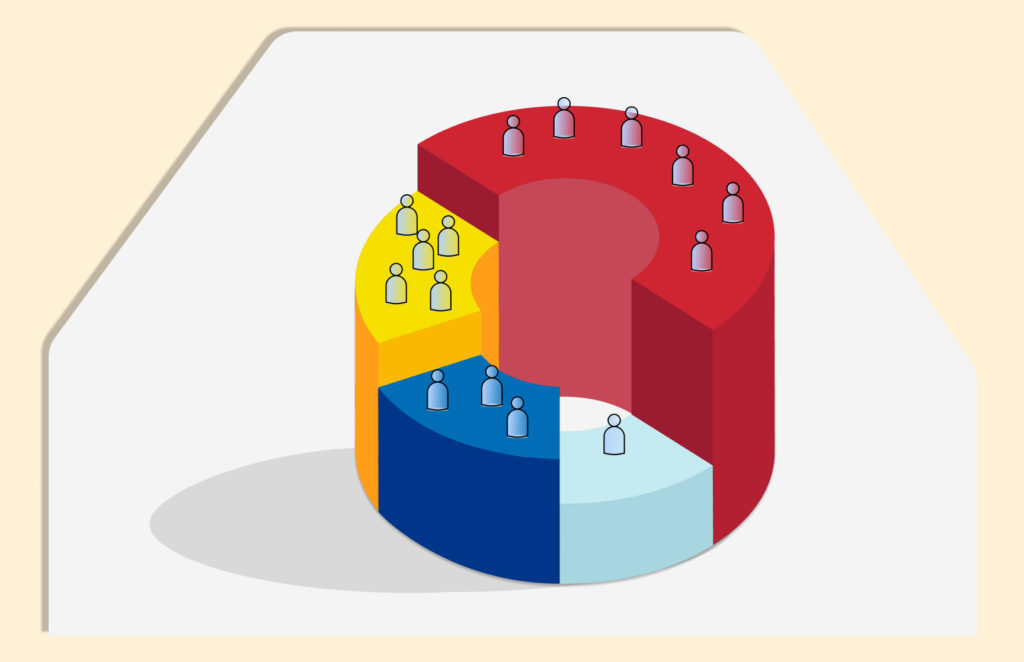

Market Segmentation

Maria Green
Market segmentation is a marketing technique that involves identifying certain customer groups in order to deliver particular goods or product lines to them in a way that appeals to their preferences.
It is a really crucial matter to research over when it comes to the growth of the business. In this guide you are not only going to get the most appropriate information, facts and findings but also a lot of interesting facts on other relevant facts of market segmentation.
So do read the post till the end and get the most accurate answers for all of your queries related to market segmentation.
Let us start by knowing the market segmentation definition.
What is Market Segmentation?
Market segmentation is essentially the strategy of breaking up your target market into reachable groups. In order to better understand the target audience, market segmentation divides a market into subsets based on demographics, requirements, priorities, shared interests, and other psychographic or behavioral factors.
You may use this targeting in your product, sales, and marketing efforts by analyzing your market segments. By influencing how you develop product offers for various segments, such as males versus women or high income versus low income, market segments can power your product development cycles.
What are the basis of Market Segmentation?
There are several bases of market segmentation including gender, occupation, marital status, age group etc.
Let us know them in detail:
1. Gender
Based on gender, marketers partition the market into smaller market segments. Given that men and women have distinct interests and preferences, segmentation is necessary.
For men, businesses need to use different marketing techniques than they would for women, which is evident.
A female would not buy a male-targeted product, and vice versa.
Numerous sectors, including the fashion, jewellery, footwear, and cosmetics industries, place a premium on gender-specific market segmentation. Create a free gender based segmentation survey now.
2. Age
One method of market segmentation is to divide the target audience into different age groups.
Teenagers would undoubtedly have distinct needs from young children in terms of items and marketing tactics.
- Age range (0 – 10 years) – Baby Products, Nappies, and Toys
- Age range (10 – 20 years) – School bags, clothing, books, and toys
- Age range (20 years and above) – Magazines, clothing, anti-aging products, and cosmetics
Create a free age based segmentation survey now.
3. Marital status
Market segmentation may also be done based on a person’s marital status. Travel agencies wouldn’t offer identical vacation packages to single people and married couples.
Create a free marital status based segmentation survey now.
4. Occupation
Office workers’ needs would differ from those of students in schools or colleges.
An item like a wacky T-shirt or a beach home shirt wouldn’t sell at a store geared toward professionals. Create a free occupation based segmentation survey now.
5. Income
According to their income, marketers partition the consumer population into small market segments. Individuals are divided into groups based on their monthly income.
These three groups are:
- Affluent group
- Group with Mid Income
- Group with Low Income
As opposed to stores that target the lower income group, those catering to the higher income group would have a distinct selection of products and marketing approaches.
In contrast to Vishal Retail, Reliance Retail, or Big Bazaar, which serve those in the lower income bracket, Pantaloons, and Shoppers Stop target the upper income market segment. Create an income based free segmentation survey now.
What are the market segmentation types?
There are four types of market segmentation that must be studied. Have a look on the most precise and inclusive meanings of the market segmentation types here:
1. Geographic segmentation
Based on geographic borders, various client groups are created through geographic segmentation.
Understanding that potential customers’ demands and interests differ depending on their geographic location, climate, and area enables you to choose where to sell and advertise a brand as well as where to build a firm. Create a survey now to understand your customers needs according to geography.
2. Demographic segmentation
Through factors including age, gender, education level, family size, occupation, ethnicity, income, and more, demographic segmentation divides a market. Due to certain items catering to evident individual demands relating to at least one demographic feature, this type of categorization into market segments is frequently used.
Age is perhaps the most evident factor of all, and because preferences change quickly during life, it is essential for marketers to comprehend this factor. Create a survey now to understand your customers needs according to demographic.
3. Psychographic segmentation
Using psychographic segmentation, the target market is divided into market segments according to their behavior, way of life, attitudes, and interests.
Focus groups, surveys, interviews, and case studies are examples of market research techniques that can be used to understand the target population. Create a free survey now to understand your market.
4. Behavioral segmentation
The goal of behavioral segmentation is to target certain responses, i.e., consumer behaviors, patterns, and the manner in which consumers make decisions and make purchases.
Examples of behavioral segmentation include consumer sentiments toward your brand, how they utilize it, and how aware they are of it. This kind of data is gathered in a manner akin to that of psychographic data. This enables marketers to create a more specialized strategy. Create a survey now to understand your customers needs according to geography
What are the benefits of Market Segmentation?
You may be asking what the biggest advantages of using the four main forms of market segmentation are now that you are aware of them.
This tactic is crucial in more ways than just breaking up your target market into manageable market segments.
1. Improvement of campaign performance
Market segmentation can help you target the right people with the right message at the right time, which will improve the effectiveness of your marketing campaigns.
You may better personalize your message to your audience’s preferences and wants by learning more about them through segmentation.
It is considerably more beneficial to target a certain group that is likely to be interested in your content or product rather than a very large audience.
If you advertise to the entire market, you will end up spending a ton of money on commercials, but only a small portion of those will result in sales. The conversion rate of your campaign can be significantly increased if you instead target a market segment with the proper traits.
2. Repurchase intentions of customers
These coherent client divisions will firstly result in excellent customer retention. Customers will have a better brand experience and are more likely to remain loyal to your brand if you can attract them at the start of a precisely personalized customer journey.
They will find it very tough to say no to you if every word and item you share with them resonates with them in some manner.
3. Areas to grow more
By identifying audience demographics that they are not already targeting with their marketing efforts, organizations can subsequently grow into new areas.
You might learn about interests that your clients have when you look at your audience statistics. For instance, a business might conduct the majority of its business in brick and mortar storefronts.
They might discover through behavioral data that many of their customers prefer to shop online. They might then either start an online store or start promoting their online marketplace more based on this information.
4. Enhance business concentration
Additionally, market segmentation can aid organizations in concentrating their efforts, allowing them to build a brand identity and become experts in a specific class of goods.
A company’s marketing will seem generic and unmemorable if it tries to appeal to everyone.
Additionally, it might cause buyers to be uncertain about the firm and brand that it stands for. Similar to this, a business that tries to sell everything is unlikely to have a significant impact in any particular market, and its products can be of inferior quality than those of businesses that specialize.
If your product selections are too broad when your business is initially starting out, it may be difficult to stand out from the competition.
5. Less spending
Correct customer communication skills enable you to use your time and resources more effectively and save money. That’s all there is to it.
The days of your team wasting time attempting to come up with something memorable are long gone. You’ll always succeed if you effectively categorize your customer base into market segments.
6. Focusing on the market rather than the money
Even if you have a sizable customer base categorized according to your strategy, if that market segment lacks the purchasing power or a genuine need for your product, your ROI won’t be favorable.
Market segmentation can be a time-consuming and challenging process, and initial mistakes may seem unavoidable. Knowing these typical mistakes can help you and your team be better prepared to avoid them in the future.
Conclusion
Every marketing team should use market segmentation as a key component of their strategy. By offering a customized message that connects with particular aspects of your clients’ lives, you demonstrate to them that you understand them. Your brand will expand dramatically if you know how to communicate ideas clearly.
Knowing your consumer base and giving them a specialized experience are the keys to market segmentation. The next step is to understand how to create an Omni channel marketing strategy for a smooth consumer journey across all of your segments.
Just keep in mind that if you don’t continually test your plan, your success won’t last very long. In order to be competitive, you must constantly be at your best.








